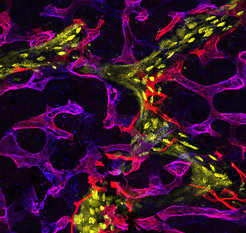Specialized vasculature: Hidden architects of long bone remodeling
Max Planck Researchers discover a third vascular player in bone remodeling
Throughout our lives, our bones are continuously remodeling to maintain strength, repair injuries and adapt to new stresses. Bone dynamics depend on two associated cell types: osteoblasts, which are responsible for bone formation, and osteoclasts, being responsible for bone resorption. Until now, it has not been understood how these cells function in the low-oxygen microenvironment of bone. Researchers at the Max Planck Institute for Molecular Biomedicine have achieved a breakthrough by discovering a new type of capillary that is involved in bone remodeling: Type R capillaries. These are a special, physiologically important group of blood vessels that are essential for maintaining healthy bones throughout adulthood and especially during the aging process.

Earlier, Ralf Adams and colleagues at the Max Planck Institute for Molecular Biomedicine had discovered so-called Type H and Type L capillaries in long bones. Type H capillaries are exclusively found in the growth plate of the bone, whereas capillaries of the L-type are found in the inner bone. Now, researchers in the team of Ralf Adams revealed another fundamental player in the skeletal system of the mouse: Type R capillaries, which are essential in the remodeling of bone – not only in adulthood, but also in aging.
Vishal Mohanakrishnan, PhD student and first author of the current study, explains the special features of the newly discovered capillary type: “Type R capillaries are unique vascular structures that emerge in adulthood and are located in trabecular bone, the spongy bone in long bones that makes up most of the bone matrix”. Type R capillaries cannot be thought of as passive conduits for the blood to flow through: “Type R capillaries communicate with the two major cell types of bone, the osteoblasts, which synthesize bone, and the osteoclasts, which are responsible for bone resorption to initiate normal bone remodeling,” Mohanakrishnan continues. The researchers showed that these Type R capillaries contribute to the oxygenation of hypoxic regions necessary for the survival and function of osteoblasts and osteoclasts. “Thus, Type R capillaries are critical in moderating the balance between bone formation and resorption,” says Mohanakrishnan.
The researchers thus found these capillaries to be the third unique and essential player in bone remodeling, along with osteoblasts and osteoclasts, all identified by immunostaining on specially prepared bone sections. Gabriele Bixel, co-author and expert in bone imaging with multiphoton microscopy in Ralf Adams’ research team, adds: “We implemented SHG imaging, which produces high-resolution images of fibrillar collagen in various tissues. The strength of SHG imaging is that it does not require any additional labeling. By combining the SHG signal intrinsic to the bone collagen fibers with the immunostaining for the different cell types, we could identify the close spatial relationship of Type R vessels with the remodeling trabecular bone.”
In the current study, the researchers also showed that Type R capillaries continue to support the bone remodeling throughout life and decrease in number near the trabecular bone. “These reductions may correlate with the loss of bone mass that occurs in aged bone,” says Mohanakrishnan. Surprisingly, compact bone, which forms the outer shaft of the skeletal bones, shows striking changes in thinning and development of cortical porosity, affecting the overall integrity of the bone and increasing the susceptibility to fracture. “We showed that in the aging mouse cortical bone, new Type R capillaries are created that actually support the remodeling process,” says Mohanakrishnan. He also sees these findings important for the future: “Therapeutic strategies may target bone vascular health and provide a holistic approach to tackle the deterioration of bone health with aging and osteoporosis.
Ralf Adams, Director at the Max Planck Institute for Molecular Biomedicine and corresponding author of the study explains: “We are very much interested in understanding the specialized functions of the different types of vascular endothelial cells in bone. Our recent discovery underscores the importance of specialized blood vessels in the bone to support the bone remodeling process in the adult and the aging body”.
Understanding the formation and maintenance of Type R vessels in the developing and aging bone is critical to maintaining healthy and stable bone. It will be important to understand the role of these specialized vessels during bone healing after fracture injury or in osteoporosis in order to develop improved strategies for bone regeneration or in bone preservation.
This interdisciplinary study by Ralf H. Adams and his team at the Max Planck Institute for Molecular Biomedicine was conducted in collaboration with an international team of researchers including Kristy Red-Horse of Stanford University USA, Taija Mäkinen of Uppsala university Sweden, Andrei S. Chagin of Karolinska Institute Sweden and was published in Nature Cell Biology.
